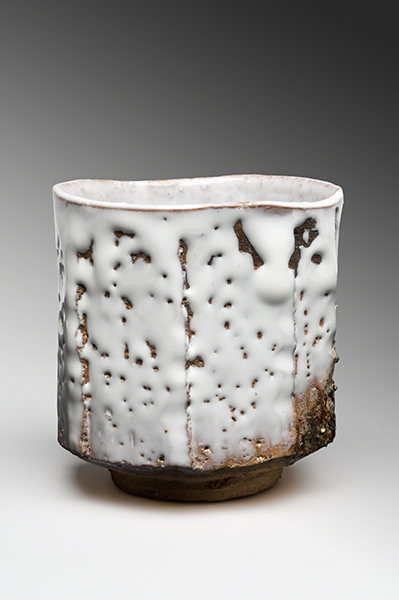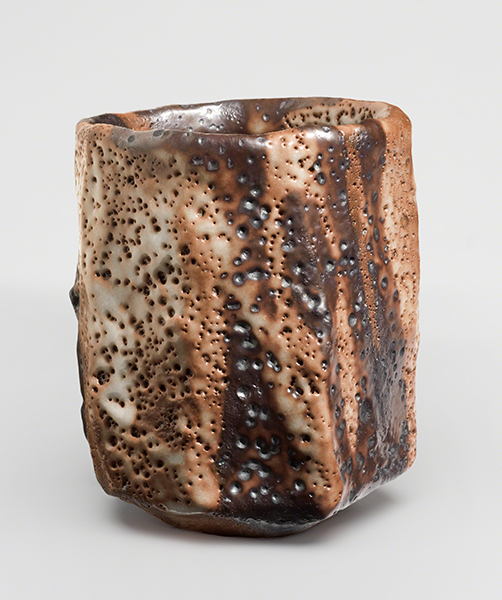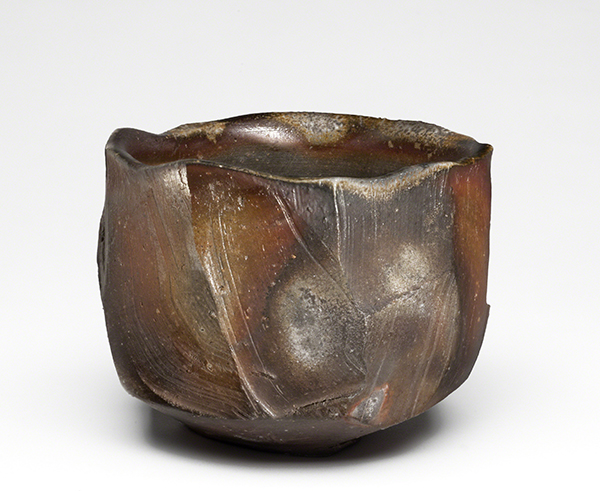Gems of the Month: Contemporary Japanese Tea Bowls
This month’s gems are contemporary artworks that serve the ages-old Japanese tea ceremony (chanoyu or sado). Tea drinking was first introduced in Japan during the Nara period (710–794) after a diplomatic visit to China. The tea ceremony did not evolve until the Momoyama period (1573–1615). The development of the tea ceremony fostered a surge in new types of ceramic wares that were considered appropriate for the ceremony, which emphasized the humble integrity of nature. Tea bowls became a source of inspiration for ceramic artists, as they continue to be to this day. The more rustic and unpolished the tea bowl looked, the more it was appreciated.
 |
| Shibuya Deishi (1927–2017, Japan), Fuyu-Oni Tea Bowl (Chawan), early 2000s. Hagi ware stoneware, 4" x 3 ¾" (10.2 x 9.5 cm). Courtesy of the Philadelphia Museum of Art. © 2023 Artist or Estate of Artist. (PMA-7071) |
A tea bowl is called chawan in Japanese. This particular example of a Hagi ware chawan is named Winter Demon (Fuyu-Oni), possibly because of its wonderful thick, white glaze. Korean ceramic artists brought Hagi ware to Japan in the early 1600s. By the 1700s, it was one of the most popular wares used for the tea ceremony. A distinctive feature of Hagi ware tea bowls is the inclusion of a foot (kodai). Hagi ware tea bowls are meant to change color seven times due to the absorption of tea into the clay.
Deishi Shibuya was a Hagi ware master. Like Hagi artists of the past, Shibuya mixed three types of local clay (diado, mishima, and mitake) from the Yamaguchi Prefecture with the inclusion of some sand, which gives the ware a porous surface. Shibuya fashioned his Hagi wares on a wooden potter's wheel from Korea. He fired his work in a traditional hillside climbing kiln, where works were fired for 15 hours. The distinctive white glaze of Shibuya's work was a combination of different straw ashes that the artist perfected over a period of 30 years.
 |
| Hidetoshi Kōchi (born 1960, Japan), Tea Bowl, ca. 2005. Shino ware ceramic, 4 ¾" x 4" (12.1 x 10.2 cm). Courtesy of the Philadelphia Museum of Art. © 2023 Kōichi Hidetoshi. (PMA-7074) |
Kōchi Hidetoshi’s work has been inspired by reactions to the Conceptualism and Minimalism movements of the 1970s. Ceramic artists countering these movements explored ceramic styles that were complex and often dramatic. Kōchi produces many works in the Shino ware and Oribe ware styles.
Shino ware is characterized by a cream-colored body and thick, white glaze of feldspar, the first white glaze used in Japanese ceramics. The name may have come from the famous tea and incense master Shino Sōshin (1444–1528), who preferred Shino ware tea bowls for his ceremony.
During the 1930s and 1940s, Japanese ceramic artists revived the Shino ware style, carefully studying Shino wares from its period of prevalence, the Momoyama period. Contemporary potters such as Hidetoshi using Shino glazes often intentionally exaggerate glaze imperfections to cause glaze skips and holes, which heighten the effect of the red marks, so the overall color looks orange. These effects are a result of carbon trapping in the firing process.
 |
| Hisamoto Kōichi (born 1953, Japan), Tea Bowl, 2008. Bizen ware ceramic, width: 4 1/4" (10.7 cm). Courtesy of the Philadelphia Museum of Art. © 2023 Kōichi Hisamoto. (PMA-7073) |
Bizen ware is known for its hardness, unglazed texture, and markings resulting from a wood-burning kiln. The clay, which is dug up in rice fields, is rich in iron, resulting in Bizen ware’s dark color. Bizen is fired over a long period of time with a wood fire kept going for 10 to 14 days.
Hisamoto Kōichi is a Bizen master. He initially began ceramics training in 1975 under a Mushiake ware master. He switched to Bizen in 1981, studying under the renowned Bizen master ceramic artist Shimamura Hikaru (born 1942). Hisamoto built his own noborigama kiln in 1989. Noborigama is a kiln that ascends (goes up) a hill. It is composed of a series of arched/vaulted chambers that buttress one another. There are piercings in the walls for each chamber to feed the next. Hisamoto named his kiln Bisan Gama, meaning “even made” in Japanese.
Correlations to Davis programs: Explorations in Art 2E Grade 3: 6.7; Experience Art: 7.3; The Visual Experience 4E: 10.10; Experience Clay 3E: chapter 4 Art History; A Personal Journey 2E: 3.5; A Community Connection 2E: 2.6; Experience Clay 2E: chapter 3 Art History


Comments